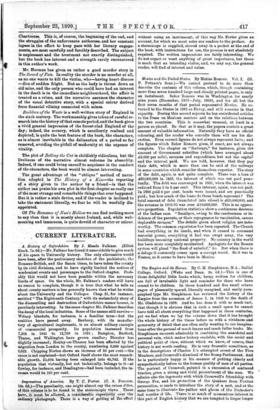CURRENT LITERATURE.
A History of Oxfordshire. By J. Meade Falkner. (Elliot Stock. 7s. 6d.)—Mr. Falkner has found it unavoidable to give much of his space to University history. The only alternative would have been, after the preliminary sketches of the prehistoric, the Romano-British, and the Saxon times, to have taken the county by its civil divisions, and to have rigidly limited the notices of academical events and personages to the Oxford chapter. Prob- ably this would not have been possible within the necessary limits of space. On the whole, Mr. Falkner's readers will have no reason to complain, though it is true that what he tells us about county matters is less generally known than what he writes about the University and the Colleges. Chap. 21, for instance, entitled " The Eighteenth Century," with its melancholy story of the dismantling and destruction of Oxfordshire manor-houses, is peculiarly interesting. In the same chapter Mr. Falkner describes the decay of the local industries. Some of the names still survive- Witney blankets, for instance, is a familiar term—but the realities have passed away. Banbury, with its manufac- tory of agricultural implements, is an almost solitary example of commercial prosperity. Its population increased from 7,308 in , 1841 to 12,768 in 1851 ; Bampton, Barford, Theme, and Wallington have grown smaller; Bicester has slightly increased; Henley-on-Thames has been affected by the migration from London to the county, numbering 5;288 against' 3,622. Chipping Norton shows an increase of 50 per cent.—the cause is not explained—but Oxford itself shows the most remark- able growth, 25,624 having been enlarged into 45,742. If the population that virtually, but not technically, belongs to it—at Cowley, for instance, and Headington—had been included, the in- crease would be 100 per cent.


































 Previous page
Previous page